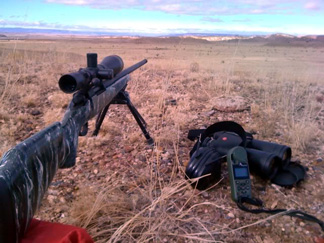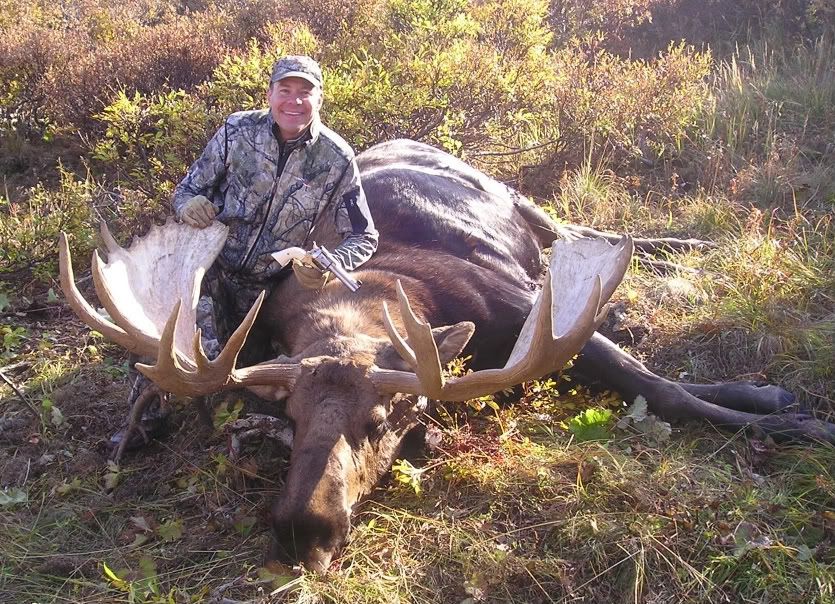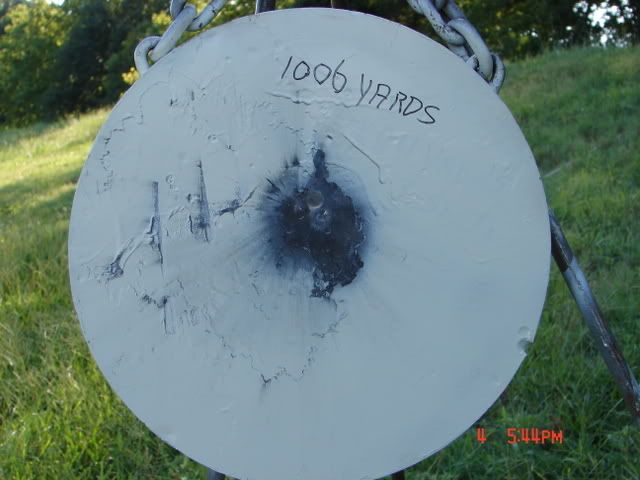

 The Accurate Reloading Forums
The Accurate Reloading Forums  THE ACCURATE RELOADING.COM FORUMS
THE ACCURATE RELOADING.COM FORUMS  Rifles
Rifles  Long Range Shooting
Long Range Shooting  Reading The Wind
Reading The WindGo  | New  | Find  | Notify  | Tools  | Reply  |  |
One of Us |
Before I give any indepth replies, I need to digest all this stuff. I will say that when I shoot in a zero wind, input zero wind in to my Droid Shooter program, I get "0" wind adjustment at 1000 yds. As soon as I enable the Spin Drift function, I get an automatic 5.9" wind drift and I've proven it to myself at 1000 yds. I don't use Spin Drift. Alan | |||
|
| One of Us |
Same here, GSSP _____________________________________________________ A 9mm may expand to a larger diameter, but a 45 ain't going to shrink Men occasionally stumble over the truth, but most of them pick themselves up and hurry off as if nothing had happened. - Winston Churchill | |||
|
| One of Us |
Pretty tough to use the PDA on the line or in the field for the most part at least for me. When you shoot enough judging condition becomes a easier. The difference between the average and a great shooter no matter who builds your rifles are the ones who can judge condition period end of story. Have seen it too many times to count. | |||
|
| One of Us |
+1, BOSS _____________________________________________________ A 9mm may expand to a larger diameter, but a 45 ain't going to shrink Men occasionally stumble over the truth, but most of them pick themselves up and hurry off as if nothing had happened. - Winston Churchill | |||
|
| One of Us |
QUOTE: What are the consequences? So those are the facts. But what does all this mean, practically, to long range target shooters? The answer lies in understanding the following: The effects of gyroscopic drift and Coriolis drift are independent, and cumulative. In other words, they add, and you can make them add up in more or less favorable ways. For example (typical 1000 yard small arms trajectory), if you always shoot in the northern hemisphere where the horizontal drift is always to the right, and you have a right twist barrel as most of us do, then your bullet will drift to the right approximately 9" due to gyroscopic drift, and an additional 2.5" due to Coriolis, resulting in 11.5" right drift, even in zero crosswind. However, if you had a left twist barrel in the northern hemisphere, gyro drift and Coriolis drift would partially offset each other, resulting in only 6.5" drift to the right. What's that mean practically, to competitive target shooters? I can think of only one answer: Long range prone shooters (perhaps some BR shooters as well) like to set a "zero wind" value on their sights as a reference point. If this zero wind setting is determined for a 100 yard zero, then it will be wrong for longer ranges. The difference between the left and right twist barrel means that the long range, no wind zero will be off by either 1/2 or 1 MOA due to the combined effects of gyroscopic and Coriolis drift. Considering this, it would be more beneficial to have a left twist barrel. Having said that, I wouldn't order a special made barrel for that reason. It might cost more, and I'm more comfortable letting the barrel makers do what they're more comfortable with. I'd do the math and adjust my long range zero wind setting before I'd special order a left twist barrel. Furthermore... As the most precise shooters on the planet, BR shooters are allowed sighters, before they begin their record shots. Allowing sighters gives BR shooters the luxury of 'dialing out' all these small components of deflection that are different on different ranges, etc. So BR shooters don’t really have to understand, or care about the effects.. However, long range hunters and snipers are people who have more of an interest in having the very first shot hit the point of aim (they require precision AND accuracy). Therefore, I think that those people may be more interested in understanding and correcting for such effects as gyroscopic drift and Coreolis drift. Of course, it may not be worth it to carry around the flushing toilet that’s required to measure the strength of the Coriolis effect that day… Regardless of how the effects add or subtract from each other, these effects are ‘knowable’, and therefore correctable by anyone who understands and accounts for them. To my knowledge, there are no commercial ballistics programs (affordable to the average shooter) that calculate gyroscopic drift. It depends on a number of aerodynamic coefficients that are not easy to calculate. However, the good news is that gyroscopic drift is relatively constant for a wide range of small arms calibers and flat fire (less than 10 degrees) trajectories. You can count on no more than 10 to 12 inches at 1000 yards. As for Coriolis acceleration, you can look that up in physics books, or ballistics books like Modern Exterior Ballistics. I have an idea for how one might alleviate some of the hassle caused by gyroscopic and Coriolis drift. Since most of us live in the Northern Hemisphere, and most of us use right twist barrels, we suffer the unfortunate consequence that the gyroscopic drift, and the lateral component of the Coriolis drift compound each other. Most of us probably have at least 1 MOA of drift to deal with on our sights between short and long range wind zeros. I haven’t done the math on this yet, but it seems that you ought to be able to figure out the correct degree of ‘cant’ at which to mount your scope, that will counteract the effects of drift. The angle should be very small, as to be indiscernible by the shooter. I doubt you would get it to work out perfectly for all ranges, but you might be able to get it ‘good enough’. This practice can also be applied to iron sights by mounting your level at a small angle to level. Some day I’ll have to do the math on that one. END QUOTE. Obviously written before the advent of PDA run portable ballistic programs which DO account for spin drift and Coriolis effect. | |||
|
| One of Us |
The "effect" is that some people rely on techology instead of developing their own skills. Then someday when TSHTF, they are SOL because they don't have those skills and the technology is not working for them, or is broken, temporarily lost, or just plain absent. Any long range shooter worth his salt has a couple of "dope books"...one on paper which he seldom uses except to study and learn from when NOT actually shooting, and one in his head. He does not complicate his shooting by worrying about various "effects". He already knows that at "X" range his center zero is "Y" minutes of windage and "N" minutes of elevation. He also knows how much to hold off (what the sight picture should look like in order to hit his target), though at long range it is more effective to adjust your sight(s) if you have the time. There are already plenty of scopes which will tell him the range, so he doesn't need a PDA and a bunch of programs which still don't (and can't) allow for all sorts of things his brain WILL see and allow for, if he teaches it to and practices doing it. Anyway, you can lead either end of a horse to knowledge, but you can't make it think. So I will concede anyone the right to believe my approach poor, or even pathetic in its primitive and out-dated ignorance. On the other hand, I will continue to feel sorry for people who have to rely on machines to tell them what isn't even necessary if they have learned from their years of shooting experiences. Shooting is a relatively simple sport, but it takes lots of disciplined practice to become self-sufficiently expert at it. But like anything else, one can make it as complex as they want. They don't need to, but they can. So, I'll just leave it at that and let everyone do it however they want....not that I could or would prevent that anyhow. | |||
|
One of Us |
Hi Alberta, I am very glad to have your thoughtful and informative posts on the matter. I am a little distressed to hear that you seem to believe that anyone here would be so foolish as to discount anything you say "primitive" or "pathetic. I certainly apologise if I gave that impression in any way in my posts; but don't think anyone is saying that at all. I posted the hiding behind the couch smiley because I couldn't argue with the substance of your post and considered myself roundly castigated in the finest traditions of long-time target shooters to cocky beginners! It's not the first time it's happened, you see... To get back to the topic I think we are not too far apart at all, I use my PDA like you use your paper dope book. A PDA can't tell you add a minute of up with peep sights at 1000 if the sun comes up behind you, but equally a dope book wouldn't alert you to the need to add a minute of windage for the Coriolis effect at 100 unless you'd shot that range enough to gather the data before. But in the final analysis you are right, nothing beats a lifetime of disciplined experience. It's just that newbies like me need all the help we can get at this stage. Best, Amir | |||
|
| One of Us |
I think it's been a really interesting thread. BH named it reading the wind and included Speedy's spin drift chart. You can't argue that spin drift and Coriolis effect aren't there. I think the reason we don't think they are significant and some don't factor them in is that: 1. Wind has a much greater influence on bullet impact. 2. Most here don't shoot at distances where it makes a difference. 3. No one in this discussion has shot in an absolutely "no wind" situation or a vacuum and has observed it Obviously BH accounts for spin drift or he wouldn't have brought it up. I have had some interesting reads from the searches I've done on the subject. Did you know that Coriolis effects the wind itself? Hathcock zeroed his rifle at the range he made his kill thereby nullifying spin drift and Coriolis. | |||
|
| One of Us |
Here's a couple of screenshots from BulletFlight. I set wind to zero; a perfect no wind situation; a vacuum. Note the inputs at the top of the screenshot. This is with the spin drift and Coriolis effect considered. Bullet will impact .8MOA right if not corrected at 1000. Heading set to 0 or firing north  . . This is with only spin drift considered. Bullet will impact .6 MOA right at 1000 if not corrected.  | |||
|
| One of Us |
Do you really believe that all bullets are effected by spin drift? I shoot far enough and I don't see it nor do I correct for it, niether does Exball  No where does the Marine training for snipers talk about nor account for spin dirft. Frank )Lowlight) owner of Snipers Hide web site and a former Marine sniper doesn't account for spindrift and that includes first round hits at 1 mile _____________________________________________________ A 9mm may expand to a larger diameter, but a 45 ain't going to shrink Men occasionally stumble over the truth, but most of them pick themselves up and hurry off as if nothing had happened. - Winston Churchill | |||
|
| One of Us |
Yes.
It seems you are shooting just fine without accounting for it so do what works for you. Wind is a much more important factor. How do you know your scope isn't so very slightly canted in the rings so it accounts for it? How do you mount your scopes? | |||
|
| One of Us |
I have a US Optics rail mounted level on the rifle and I plumb the reticle to the level _____________________________________________________ A 9mm may expand to a larger diameter, but a 45 ain't going to shrink Men occasionally stumble over the truth, but most of them pick themselves up and hurry off as if nothing had happened. - Winston Churchill | |||
|
| One of Us |
John---it is a stone cold fact that spin drift does exist. When you set world records for accuracy and have worked with people at Aberdeen and at Picatinny Arsenal for as long as Speedy has plus the skins on the wall being a HOF shooter the folks qualifications at the “Hide” kind of pale in comparison when talking about BR accuracy. | |||
|
| One of Us |
Here's something that you may be interested in. My gunsmith has built a precision scope mounting jig. Very few people, including manufacturers, have gone to the trouble he has designing and building the device. He has a 10 foot board that is marked with a vertical line, laser leveled, marked in MOA and MIL accurately for the distance it is away from the precision scope jig. The method is the most precise there is and eliminates the scope from being canted in the rings even so slightly that it cannot be detected without it. Your scope most likely is not mounted as precisely and is probably turned in the rings. 
By the way, Speedy accounts for spin drift, Boss Hoss does and so do military snipers.
| |||
|
| One of Us |
First off I said that it did not exist, but there are for more impartant factors IME. Again I am not a compition shooter, I am a hunter. Shawn Carlock and several other that I know donot adjust for spin drift with the 300 SMK and they have made kills out to 1900 yards. Gereald Perry maker of Exball believes that Spin drift is bullet dependant. I just know my results and that of others and the fact is that some adjust for spin drift constantly and others do not. If I have a problem missing right then I will record that and enter it into the spin drift function on Exbal, so far that is not the case _____________________________________________________ A 9mm may expand to a larger diameter, but a 45 ain't going to shrink Men occasionally stumble over the truth, but most of them pick themselves up and hurry off as if nothing had happened. - Winston Churchill | |||
|
| Powered by Social Strata | Page 1 2 3 4 |
| Please Wait. Your request is being processed... |
|

Visit our on-line store for AR Memorabilia

